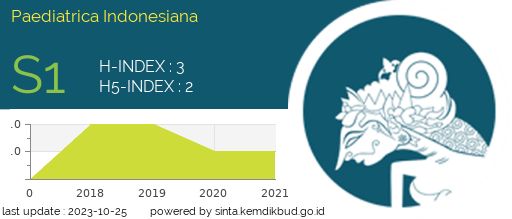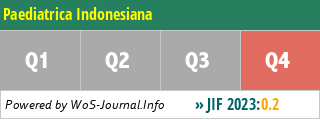Vitamin D3 and seizure frequency in children with epilepsy using polypharmacy
Abstract
Background Children with epilepsy usually need vitamin D administration, primarily due to the effects of antiepileptic drugs (AEDs). The use of AEDs, particularly polypharmacy, can reduce serum 25(OH)D levels. Vitamin D improves the function of neurotransmitters furthermore boosting the seizure threshold. There has been relatively little study investigating the effects of vitamin D3 treatment on seizure frequency.
Objective To compare seizure frequency before and after administering vitamin D3 to the children with epilepsy who used polypharmacy.
Methods Sixteen children with epilepsy and polypharmacy, aged 2-18 years, from the Pediatric Neurology Clinic, Dr. Kariadi Hospital, Semarang, were studied using a quasi-experimental approach with one group pretest-posttest. The vitamin D3 was given orally for two months with different dosages according to age andsubjects’ pretest serum 25(OH)D levels. Children with vitamin D insufficiency or deficiency were giventherapy dosage, and the normal vitamin D status were given supplementation dosage.Seizure frequency, serum 25(OH)D levels, and vitamin D status were assessed before and after treatment.
Results Seizure frequency was significantly lower after vitamin D treatment for the entire group compared to pre- administration (P=0.019). For subjects with hypo-vitamin D levels pre-treatment, median seizure frequency was significantly decreased following normalization of vitamin D levels at one month (P=0.016) and two months (P=0.018) of vitamin D treatment. Using mean data, seizure frequency also significantly decreased at one month and at two months post-treatment.
Conclusion Vitamin D3 administration is associated with an increase in serum 25(OH)D levels, as well as a decrease in seizure frequency. Vitamin D3 administration can significantly reduce seizure frequency in epilepsy patients undergoing polypharmacy who are vitamin D deficient.
References
Andrianti PT, Gunawan PI, Hoesin F. Profil epilepsi anak dan keberhasilan pengobatannya di RSUD Dr. Soetomo tahun 2013. Sari Pediatri. 2016;18:34-9. DOI: https://doi.org/10.14238/sp18.1.2016.34-39
Aaberg KM, Gunnes N, Bakken IJ, Lund Søraas C, Berntsen A, Magnus P, et al. Incidence and prevalence of childhood epilepsy: a nationwide cohort study. Pediatrics. 2017;139:e20163908. DOI: https://doi.org/10.1542/peds.2016-3908
Pendo K, DeGiorgio CM. Vitamin D3 for the treatment of epilepsy: basic mechanisms, animal models, and clinical trials. Front Neurol 2016;7:218. DOI: https://doi.org/10.3389/fneur.2016.00218
Durá-Travé T, Gallinas-Victoriano F, Malumbres-Chacón M, Moreno-Gónzalez P, Aguilera-Albesa S, Yoldi-Petri ME. Vitamin D deficiency in children with epilepsy taking valproate and levetiracetam as monotherapy. Epilepsy Res. 2018;139:80–4. DOI: https://doi.org/10.1016/j.eplepsyres.2017.11.013
He X, Jiang P, Zhu W, Xue Y, Li H, Dang R, et al. Effect of antiepileptic therapy on serum 25(OH)D3 and 24,25(OH)2D3 levels in epileptic children. Ann Nutr Metab. 2016;68:119–27. DOI: https://doi.org/10.1159/000443535
Nagarjunakonda S, Amalakanti S, Uppala V, Rajanala L, Athina S. Vitamin D in epilepsy: vitamin D levels in epilepsy patients, patients on antiepileptic drug polytherapy and drug-resistant epilepsy sufferers. Eur J Clin Nutr. 2016;70:140–2. DOI: https://doi.org/10.1038/ejcn.2015.127
Teagarden DL, Meador KJ, Loring DW. Low vitamin D levels are common in patients with epilepsy. Epilepsy Res. 2014;108:1352–6. DOI: https://doi.org/10.1016/j.eplepsyres.2014.06.008
Likasitthananon N, Nabangchang C, Simasathien T, Vichutavate S, Phatarakijnirund V, Suwanpakdee P. Hypovitaminosis D and risk factors in pediatric epilepsy children. BMC Pediatr. 2021;21:432. DOI: https://doi.org/10.1186/s12887-021-02906-7
Rekam Medis Rumah Sakit Dr. Kariadi Semarang. (2023).
Cho YS, Ah Y-M, Jung AH, Kim KJ, Lee J-Y. Trends in antiepileptic drug prescriptions for childhood epilepsy at a tertiary children’s hospital in Korea, 2001–2012. Paediatr Drugs. 2015;17:487–96. DOI: https://doi.org/10.1007/s40272-015-0147-z
Elmazny A, Amer H, Rashed L, Khalil S, Magdy R. Vitamin D status of untreated children and adolescent Egyptian patients with genetic generalized epilepsy: a case–control study. Epilepsy Behav. 2020;103:106840. DOI: https://doi.org/10.1016/j.yebeh.2019.106840
Miratashi Yazdi SA, Abbasi M, Miratashi Yazdi SM. Epilepsy and vitamin D: a comprehensive review of current knowledge. Rev Neurosci. 2017;28:185–201. DOI: https://doi.org/10.1515/revneuro-2016-0044
Cebeci AN, Ekici B. Epilepsy treatment by sacrificing vitamin D. Expert Rev Neurother. 2014;14:481–91. DOI: https://doi.org/10.1586/14737175.2014.905742
Groves NJ, McGrath JJ, Burne THJ. Vitamin D as a neurosteroid affecting the developing and adult brain. Annu Rev Nutr. 2014;34:117–41. DOI: https://doi.org/10.1146/annurev-nutr-071813-105557
Han P, Trinidad BJ, Shi J. Hypocalcemia-induced seizure. ASN Neuro. 2015;7:1759091415578050. DOI: https://doi.org/10.1177/1759091415578050
Holló A, Clemens Z, Kamondi A, Lakatos P, Szűcs A. Correction of vitamin D deficiency improves seizure control in epilepsy: a pilot study. Epilepsy Behav. 2012;24:131–3. DOI: https://doi.org/10.1016/j.yebeh.2012.03.011
Rajesh A, Mukhtyar B. EPEN Clinical guidelines: Vitamin D supplementation in children with epilepsy. East Paediatr Epilepsy Netw. 2018;2:1–8. Available from: https://epen-uk.com/wp-content/uploads/2021/05/Vit-D-in-epilepsy-1.pdf
McNally JD, Iliriani K, Pojsupap S, Sampson M, O’Hearn K, McIntyre L, et al. Rapid normalization of vitamin D levels: a meta-analysis. Pediatrics. 2015;135:152–66. DOI: https://doi.org/10.1542/peds.2014-1703
Beuzit C, L’Hour M-C, Roudaut S, Gouillou M, Metz C, Moineau M-P, et al. Prevalence of vitamin D deficiency in children aged 5-10 years in Western Brittany. Arch Pédiatr 2015;22:1112–8. DOI: https://doi.org/10.1016/j.arcped.2015.08.013
Dong N, Guo H-L, Hu Y-H, Yang J, Xu M, Ding L, et al. Association between serum vitamin D status and the anti-seizure treatment in Chinese children with epilepsy. Front Nutr. 2022;9:968868. DOI: https://doi.org/10.3389/fnut.2022.968868
Shellhaas RA, Barks AK, Joshi SM. Prevalence and risk factors for vitamin D insufficiency among children with epilepsy. Pediatr Neurol. 2010;42:422–6. DOI: https://doi.org/10.1016/j.pediatrneurol.2010.03.004
Chaudhuri JR, Mridula KR, Rathnakishore C, Balaraju B, Bandaru VS. Association of 25-hydroxyvitamin D deficiency in pediatric epileptic patients. Iran J Child Neurol. 2017;11:48–56. Available from: https://www.ncbi.nlm.nih.gov/pmc/articles/PMC5493830/
Tombini M, Palermo A, Assenza G, Pellegrino G, Benvenga A, Campana C, et al. Calcium metabolism serum markers in adult patients with epilepsy and the effect of vitamin D supplementation on seizure control. Seizure. 2018;58:75–81. DOI: https://doi.org/10.1016/j.seizure.2018.04.008
Daliyanti DS. Profil kadar vitamin D dan peran terapi suplementasi pada anak epilepsi. [thesis]. Jakarta: Universitas Indonesia; 2017.
Li X-H, Hou X-Y, Chen R. The roles of vitamin B12 and vitamin D in children with intractable epilepsy. Int J Clin Exp Med. 2015;8:764–9. Available from: https://www.ncbi.nlm.nih.gov/pmc/articles/PMC4358510/
Alhaidari HM, Babtain F, Alqadi K, Bouges A, Baeesa S, Al-Said YA. Association between serum vitamin D levels and age in patients with epilepsy: a retrospective study from an epilepsy center in Saudi Arabia. Ann Saudi Med. 2022;42:262–8. DOI: https://doi.org/10.5144/0256-4947.2022.262
Rahman D. Pengaruh pemberian suplementasi vitamin D terhadap perubahan kadar TNF-α dan perubahan frekuensi bangkitan pada pasien epilepsi. [thesis]. Semarang: Universitas Diponegoro; 2022.
Published
How to Cite
Issue
Section
License
Copyright (c) 2025 Setya Puspa Dewi Aprilyani, Alifiani Hikmah Putranti, Tun Paksi Sareharto, Farid Agung Rahmadi, Rina Pratiwi

This work is licensed under a Creative Commons Attribution-NonCommercial-ShareAlike 4.0 International License.
Authors who publish with this journal agree to the following terms:
Authors retain copyright and grant the journal right of first publication with the work simultaneously licensed under a Creative Commons Attribution License that allows others to share the work with an acknowledgement of the work's authorship and initial publication in this journal.
Authors are able to enter into separate, additional contractual arrangements for the non-exclusive distribution of the journal's published version of the work (e.g., post it to an institutional repository or publish it in a book), with an acknowledgement of its initial publication in this journal.
Accepted 2025-04-16
Published 2025-04-25













